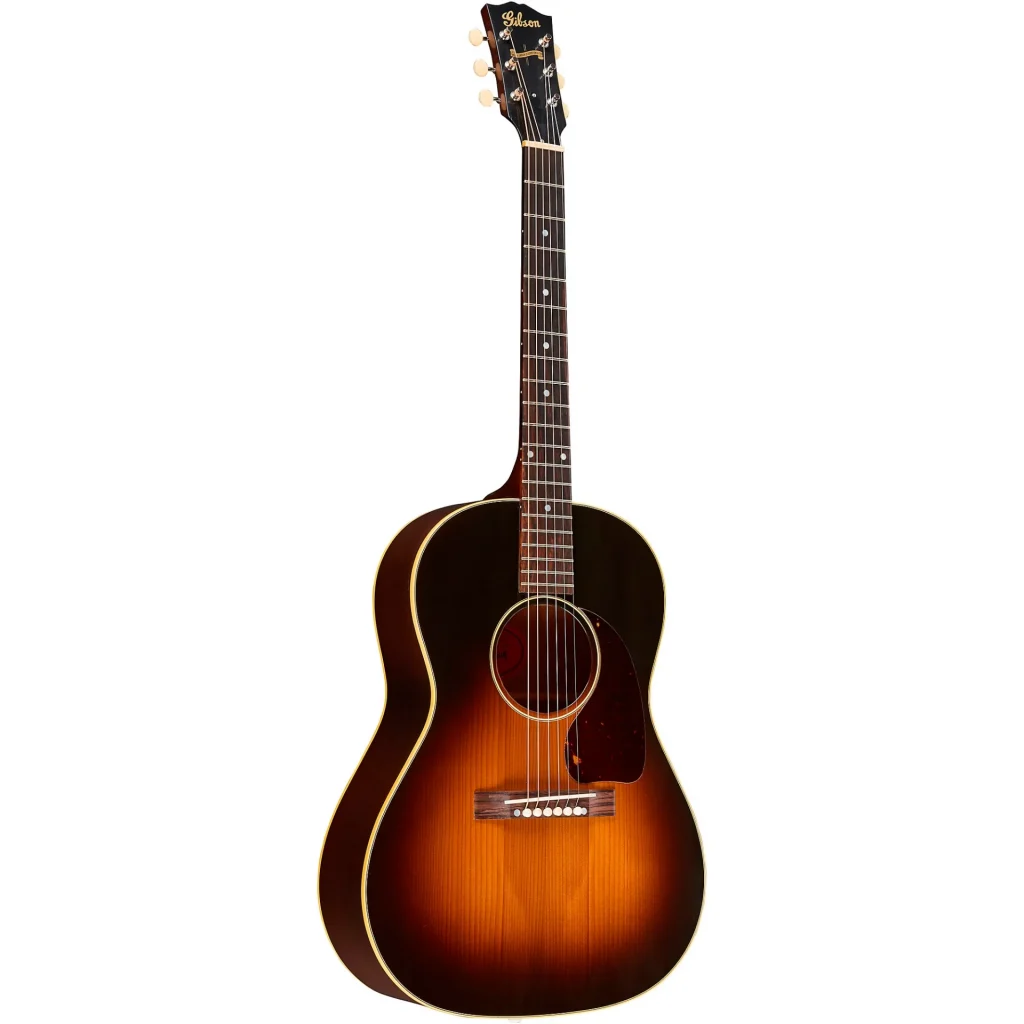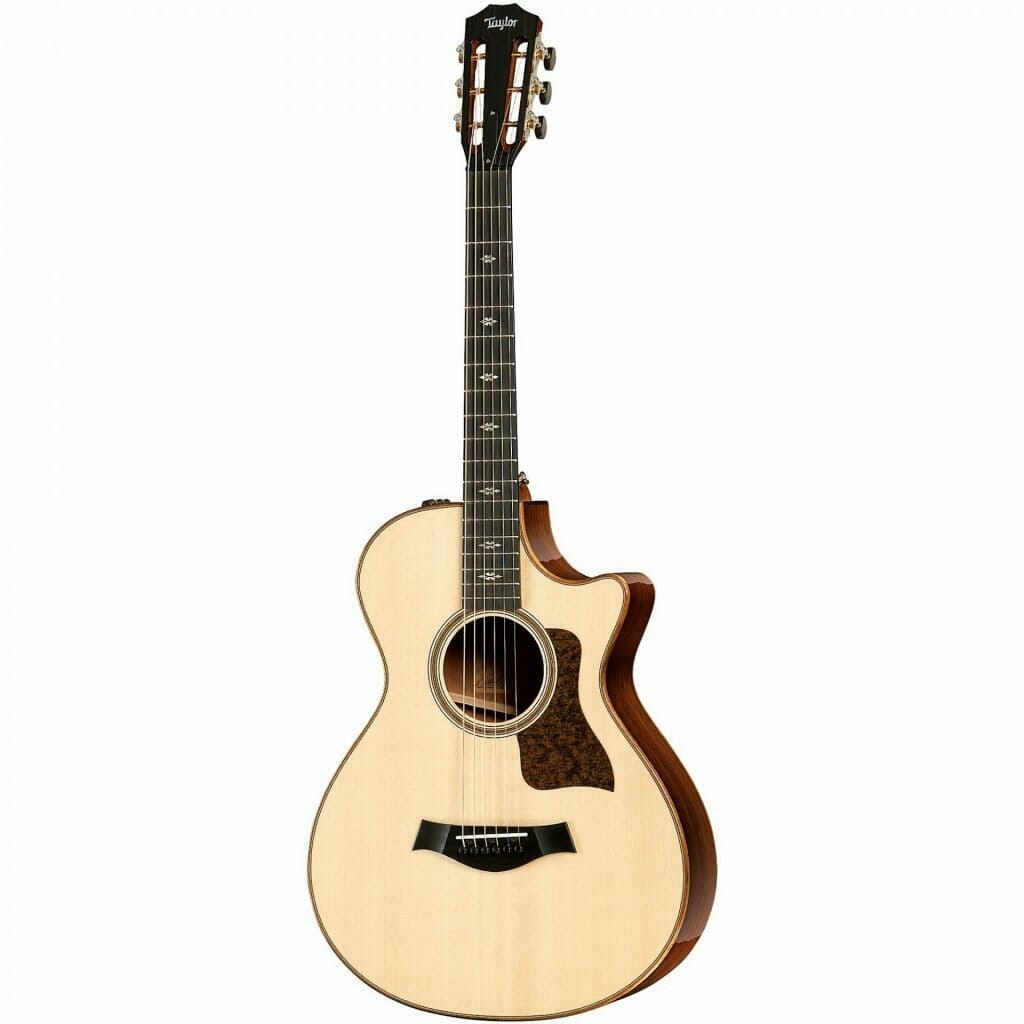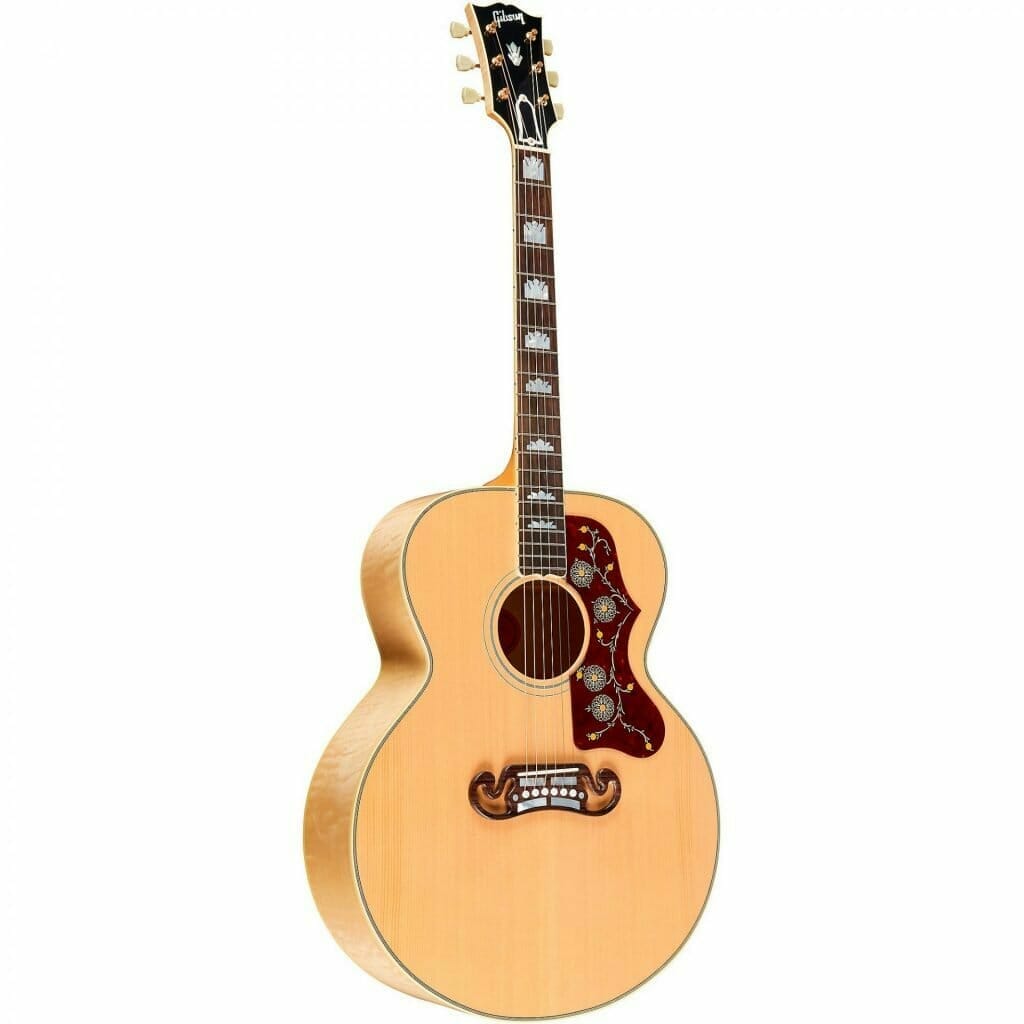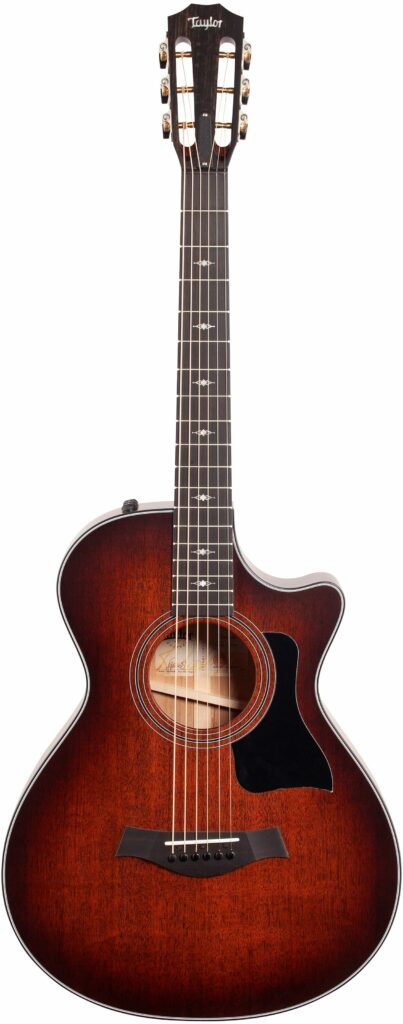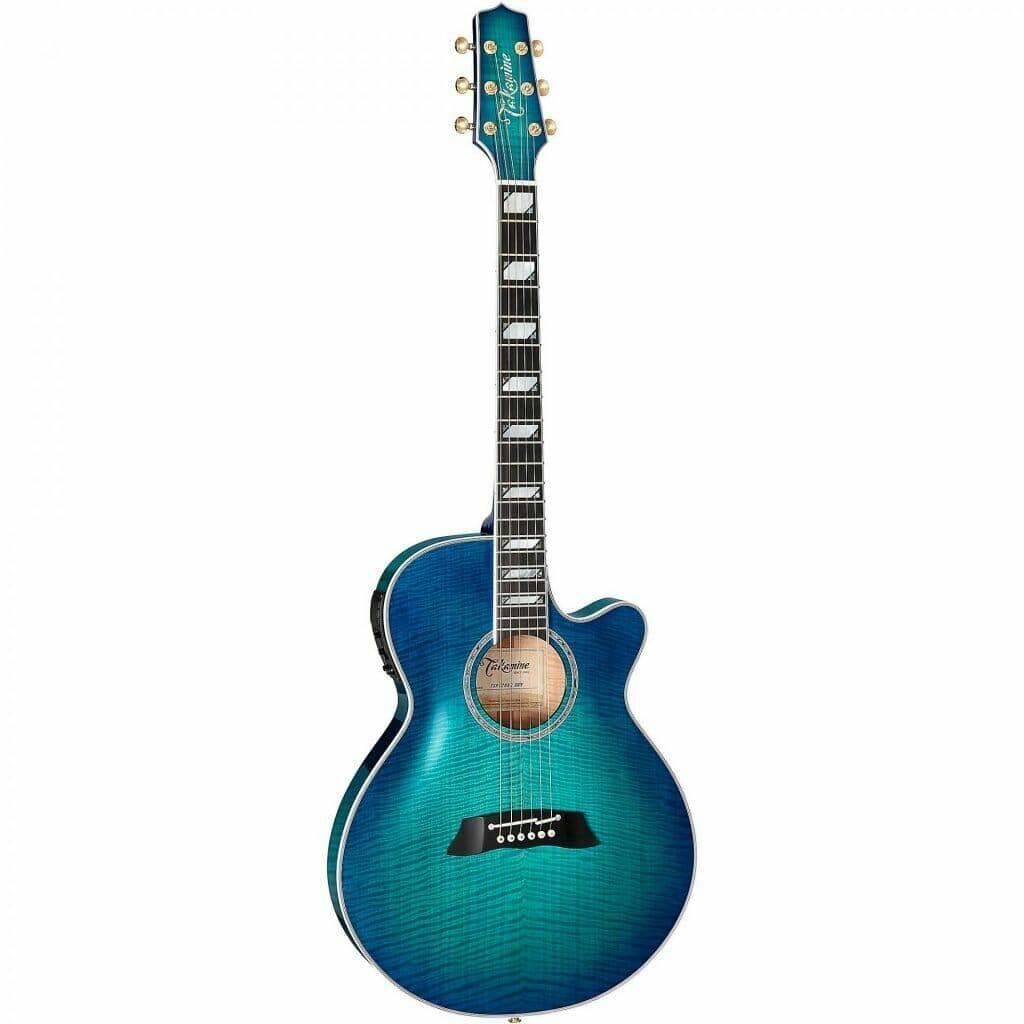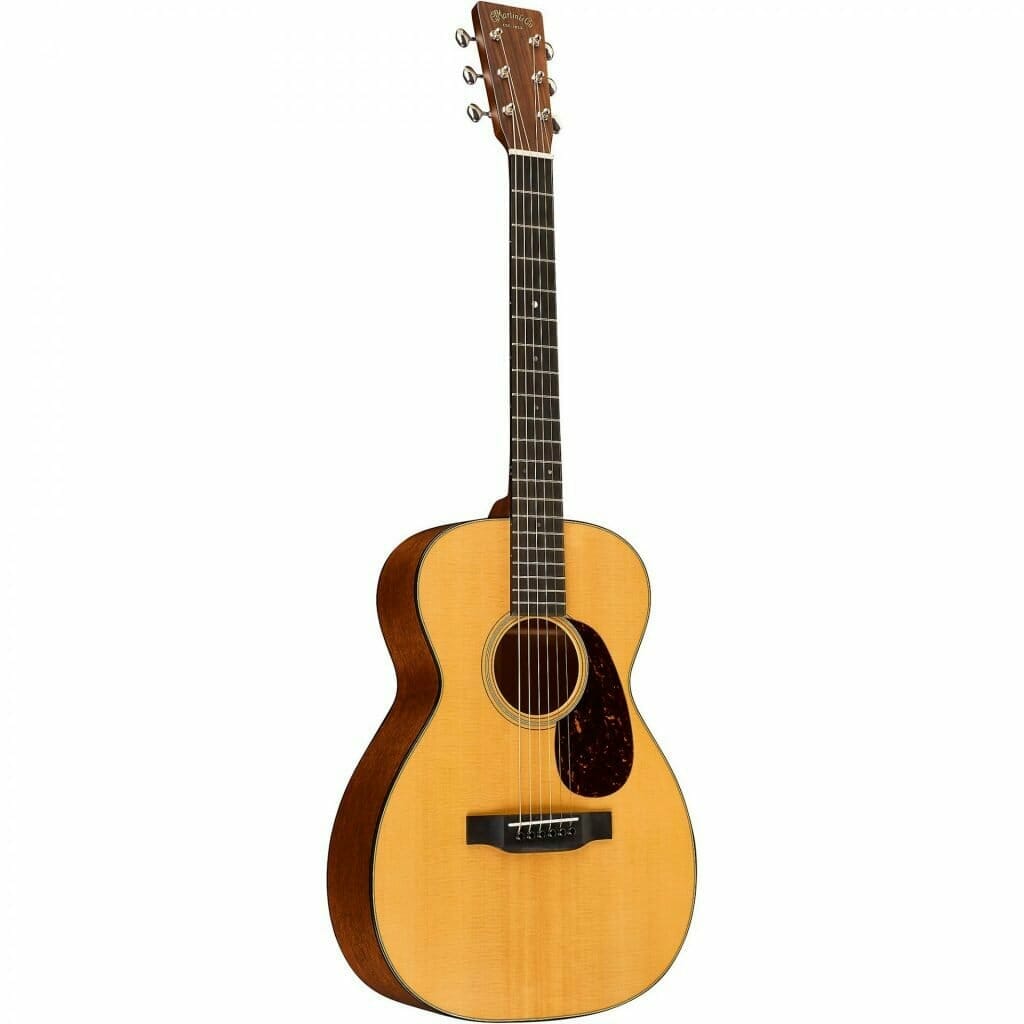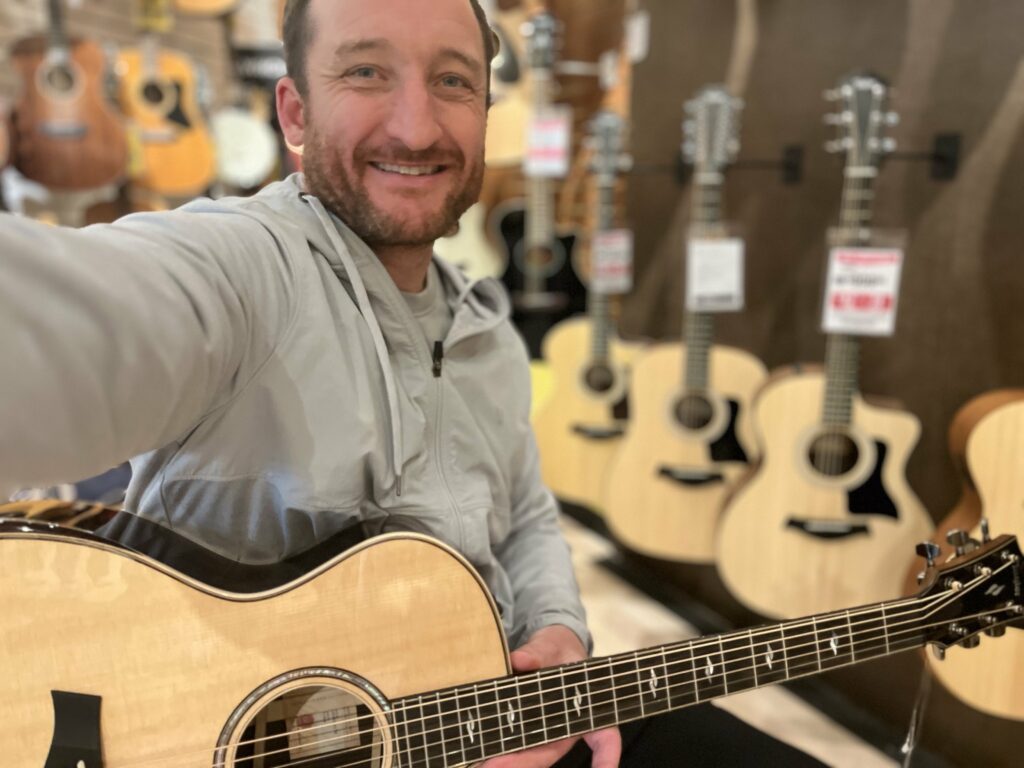Finding the best high-end acoustic guitars can be difficult because most guitar shops don’t carry many in their inventory.
This is a problem for two reasons. First, you may be unable to try out all the models you’re interested in before making a purchase decision. Second, it makes your search much more complicated than it needs to be.
I’ve done the work for you by creating a list of the best high-end guitars. This will help you make an informed decision and get a guitar perfect for your expertise and playing style.
I’ve put my 25+ years of guitar playing, countless hours in guitar stores, and reading user-generated reviews to create a comprehensive list of the best high-end guitars. This will help you get a guitar perfect for your expertise and playing style.
Also, I’ve included guitars that have left-handed versions for all of you southpaws 😉
Sit back, grab your favorite drink, and let’s get started!
The Short Answer
If you’re looking for a modern classic that is beautifully constructed, can handle a variety of genres and playing styles, and sounds incredible, the best high-end acoustic guitars is the Taylor 914 series (read full review here).
If you looking for a beautiful and balanced tone that is familiar and welcoming, check out the Martin OM-28.
-Brad Johnson (Founder/Writer of Song Production Pros)
Table of Contents
Best Overall: Taylor 914
- Topwood: Solid Sitka Spruce
- Body Wood: Indian Rosewood
- Body Shape: Grand Auditorium
- Bracing: V-Class
- Neck Wood/Radius: Tropical Mahogany/15''
- Fingerboard: West African Ebony
- Frets: 20
- Electronics: ES-2
- Case: Hardshell Case
The 914 V-Class by Taylor Guitars is the perfect choice for the discerning guitarist who wants only the best. This guitar is built with high-quality materials and craftsmanship, which shows in its sound and performance.
This guitar is incredibly versatile and responsive to all playing styles, making it a joy to play. And the beautiful modern design is sure to turn heads wherever you play it.
- Crystal clear sound that responds beautifully to all playing styles
- Taylor is one of the most innovative, cutting-edge builders of guitars today
- It plays with a buttery smoothness that is unparalleled
- It's a beautiful instrument that will last you for a lifetime
- The look and tone might be too modern for some players
Full Review:
The 914 by Taylor Guitars gets top honors for being one of the best high-end acoustic guitars. This is because it’s incredibly versatile, plays well, and is a beautiful-looking modern acoustic-electric guitar.
This guitar features a solid Sitka spruce top and solid Indian rosewood back and sides. This classic tonewood combination produces a harmonically rich and dynamic sound that responds beautifully to all playing styles. The guitar tone blooms and swirls as you play through your song.
What makes this guitar worth every dollar of its high-price tag comes down to the details.
Read the Rest of the Review…
First, Taylor has three proprietary design elements you won’t find in any other acoustic guitar on this list.
- V-Class Bracing
- Expression System 2 Electronics
- NT Neck Design
V-Class Bracing was introduced to the world by Taylor’s Head Luthier Andy Powers in 2018. This innovation was a significant pivot to the X-Brace design used in most acoustic guitar designs developed by Martin in 1843.
V-Class bracing gives a guitar better intonation, sustain, and projection. This makes the guitar sound more open, round, and expressive no matter what part of the neck you’re playing.
-Brad Johnson (Founder/Writer of Song Production Pros)
Speaking of neck, Taylor’s NT Neck Design on the 914’s ebony fretboard can save you a hefty repair bill later.
Instead of gluing the mahogany neck of the 914 into the acoustic guitar body (dovetail joint), the NT System doesn’t use glue. It can be easily adjusted in a matter of minutes. Last I checked, a neck reset from my local Luthier was shy of $1,000 for traditional necks (ouch!).
The other Taylor-only innovation is the Expression System 2 Electronics. This proprietary system features a behind-the-saddle pickup with three calibrated pickup sensors to give your plugged-in tone authenticity and accuracy in its natural tone.
If electronics aren’t what you’re looking for, there is a 914 that doesn’t include them, and you can save a couple of hundred dollars off your purchase price.
The 914 features a mahogany neck with an ebony fingerboard, a classic wood combination that gives a “buttery” playing experience characteristic of Taylor Guitars.
This acoustic-electric guitar has an understated beauty, but when you look closely at the guitar, you will notice the incredible attention to detail in its construction.
The most notable design features are the ebony armrest and the beautiful abalone fret and headstock inlays.
The ebony armrest helps keep a guitar player’s arm off the soundboard to help with the overall resonance and quality of the guitar’s tone.
While this guitar is wonderfully constructed, lightweight, and plays like a dream, it isn’t for everyone.
Some players might find the high-fidelity of the guitar’s tone too bright and modern. There is nothing vintage about this guitar; it lacks the sense of warmth and intimacy you will find with other guitars on this list.
However, suppose you’re a guitar player looking for a highly reliable, premium acoustic guitar that can do it all. In that case, the 914 will not disappoint you.
It’s a bonus that Taylor is leading sustainability efforts in manufacturing and labor. There is much to feel good about when purchasing this excellent guitar from Taylor!
Best Classic Tone: Martin OM-28 Modern Deluxe
- Topwood: Solid Spruce
- Body Wood: Solid East Indian Rosewood
- Body Shape: Orchestra
- Bracing: Scalloped X-Bracing
- Neck Wood/Radius: Genuine Mahogany/16''
- Fingerboard: Ebony
- Frets: 20
- Electronics: Fishman Aura VT Blend (Paid Upgrade)
- Case: Hardshell Case
The OM-28 Modern Deluxe strikes the perfect balance of old and new, with a rich tone that will make your heart sing.
The OM-28E is part of Martin's Vintage Tone System, giving the guitar a sought-after vintage sound. But this guitar is more than just a pretty face - it's also built to last, with a high-quality construction that will keep you playing for years to come.
- The OM-28 is a high-end guitar with a rich, vintage tone and a classic look
- Own an instrument with history and tradition
- Liquid metal bridge pins improve the sustain and clarity of the guitar
- The OM construction adds extra high-end sparkle and depth to the 000 body style
- The neck weight is slightly heavy
- Some players may prefer the shorter-scale 000 body
Full Review:
Martin Guitars is the OG manufacturer of acoustic instruments, and their guitars have a legendary build and tone.
The Martin OM-28, in particular, has a rich tone that sounds familiar and inviting. When you strum the OM-28E, every note is articulate and present, and the sound just hits you in the heart.
Martin developed the Modern Deluxe lineup of guitars to give players a vintage-style guitar with modern design elements.
Martin Guitars developed their Vintage Tone System to accomplish the holy grail of vintage tone that guitar players seek. The Vintage Tone System ages the solid Sitka spruce top, giving the guitar a look and sound of a guitar built decades ago.
Read the Rest of the Review…
This high-end acoustic guitar features solid East Indian Rosewood back and sides for classic sound quality when paired with the solid Sitka spruce top.
Vintage guitars often have big, bulky necks. So on the OM-28 Modern Deluxe, Martin has created an asymmetrical neck profile that changes shape while playing up and down the neck, making for a more modern, comfortable playing experience.
While the OM full-scale length gives the “000” body design more depth, punch, and high-end articulation.
Another modern design feature on the OM-28 is the liquid metal bridge pins and very lightweight carbon fiber bridge plate.
The liquid metal bridge won’t absorb any of the string vibrations, which improves the sustain and clarity of the guitar’s sound. While the carbon fiber bridge plate doesn’t add unnecessary weight to the top of the guitar, so it resonates more freely.
The pinched waist of the OM body gives the guitar extra articulation, focus, and punch to the sound and makes it a versatile guitar for guitar players.
The OM-28 Modern Deluxe can be purchased with Fishman Aura VT electronics or without. Suppose you don’t find yourself gigging out often. In that case, you can save yourself several hundred dollars by getting the guitar without it.
However, suppose you want the most versatile and feature-rich version. In that case, the Fishman electronics will exceed your expectations for what a plugged-in tone can sound like.
The Adjustable Aura Image Technology is built into the electronics, which allows you to blend studio-recorded sound into your pickup sound. This gives a level of depth and quality often missing in standard piezo acoustic guitar pickups.
While the OM-28 Modern Deluxe is a beautiful guitar with a world-class tone, it’s not for everyone. If you’re looking for a guitar to play fingerstyle, jazz, or bluegrass, the OM-28 neck may be too bulky for you.
However, if your main focus is strumming and playing folk songs at jam sessions with friends, the OM-28 has the rich tone and character you need.
Best for Folk & Blues: Gibson LG-2 1942
- Topwood: Thermally Aged Red Spruce
- Body Wood: Mahogany
- Body Shape: LG-2
- Bracing: Scalloped X-Bracing
- Neck Wood/Radius: Mahogany/12''
- Fingerboard: Rosewood
- Frets: 20
- Electronics: N/A
- Case: Hardshell Case
This guitar's vintage design and construction make it a genuine collector's item. If you're looking for an authentic World War II-era guitar, the Gibson Custom 1942 Banner LG-2 is a perfect choice.
The red spruce top gives the Banner LG-2 a more transparent, assertive, and dynamic sound, perfect for folk and blues music.
- Blast to the past with this vintage-inspired guitar
- The tone is clear, dynamic, and bluesy
- Torrified spruce top makes the guitar sound like it was built decades ago
- Made in Montana, USA, with beautiful handmade construction
- This guitar has a specific tone and isn't modern or versatile
- You may go on a long waiting list to own one
Full Review:
The 1942 Banner LG-2 is brimming at the seams with mojo and character. This acoustic guitar isn’t the most versatile instrument on the list, but it excels at what it does best. Giving you an enjoyable, authentic playing world war two era guitar.
This handcrafted guitar has a torrified solid red spruce top and solid mahogany back and sides. Red Spruce (also known as Adirondack Spruce) is known for being more transparent, assertive, and more dynamic compared to other Spruces. This helps give this guitar a surprising punch for being so small.
This torrification on the 1942 is why I select this guitar over the other LG-2 high-end acoustic guitars in Gibson’s lineup. The tone of Gibson’s acoustics are often seen as the antithesis of the modern sound of Taylor’s and the like. This aging process gives you the best of both worlds. A new Gibson Guitar that has the character of a rare relic.
Read the Rest of the Review…
This acoustic guitar’s short scale and narrow waist give the Banner LG-2 a remarkable clarity across all notes and strings.
The Gibson LG-2 1942 responds quickly to a light touch. This makes it perfect for fingerstyle musicians and songwriters who perform in small, intimate settings.
The tone of this guitar is distinct, “woody,” and worn-in. This makes the LG-2 an excellent choice for blues players and folk music musicians.
Suppose you’re a musician searching for an acoustic guitar tone that feels nostalgic, cool, and vintage that is perfect for blues and folk music. In that case, the Gibson Custom 1942 Banner LG-2 is an attractive option!
Best for Fingerstyle: Taylor 812 Series
- Topwood: Solid Sitka Spruce
- Body Wood: Indian Rosewood
- Body Shape: Grand Concert (Cutaway & Non-Cutaway
- Bracing: V-Class
- Bridge: Ebony Bridge
- Neck Wood/Radius: Mahogany/12''
- Fingerboard: West African Ebony
- Frets: 20 (12-Fret Design)
- Electronics: ES-2
- Case: Hardshell Case
This Taylor 812 12-fret design works exceptionally well for fingerstyle players. This guitar responds quickly, is easy to play, and has a rich and balanced tone.
If you're looking for something to help bring out the tiny nuances in your playing, this high-end acoustic guitar is worth a closer look.
- It's perfect for light playing styles and intimate settings
- It has a rich, dynamic sound that's articulate, modern, and punchy
- Crafted with the utmost care and attention to detail
- Great for fingerpicking, smaller hands, and small frames
- If you're a larger-framed player, the guitar might feel too small in your hands
- Not the guitar for players who want to play in the upper registers (past 12th fret)
Full Review:
The 812 Series by Taylor Acoustic is a beautiful guitar designed with intimacy and delicate playing in mind.
The Grand Concert body shape matched with a short-scale, 12-fret tropical mahogany neck makes this guitar have “slinky” playability and more pronounced mids and lows. This guitar quickly responds to a light playing style while maintaining good resonance and single-note articulation.
One thing that I love about the 812 Series (besides how easy they are to play and how awesome they sound) is that you have options on a cutaway and non-cutaway version and a nylon string version for classical fingerstyle guitarists.
Read the Rest of the Review
What also makes that unique for this small-bodied guitar is that while the design is perfect for fingerstyle, it holds up surprisingly well to heavy strumming without losing clarity. This is due to the innovative V-Class bracing, solid Sitka spruce, and East Indian Rosewood back and sides pairing.
This guitar is more than a one-trick pony and is very versatile.
If you enjoy singing while playing guitar, the 812 is a fantastic guitar for you.
The solid Indian rosewood back and sides scoop out the midrange, allowing vocals to sit within this pocket and seamlessly blend in with the guitar’s tone.
This guitar looks deceptively simple at first glance. Still, as you inspect the guitar further, you see the craftsmanship and attention to detail that built every aspect of this high-end acoustic guitar.
-Brad Johnson (Founder/Writer of Song Production Pros)
With its beveled armrest, maple binding, and Taylor slot head tuners, this instrument will surely please any musician looking for a non-flashy but elegant guitar.
Like the other Taylor’s on this list, the 812 comes equipped with Taylor’s Expression System 2. You can plugin and be confident that this guitar’s beautiful acoustic tone will translate through any speaker system you play it through. However, if you are a purist and don’t need electronics in your acoustic instrument, you can purchase the non-cutaway version without it and save a couple of hundred bucks.
This highly versatile guitar is great for players who specialize in playing with their fingers and those with smaller hands and frames.
Best for Flatpicking & Strumming: Gibson SJ-200 Series
- Topwood: Solid Sitka Spruce
- Body Wood: Maple (Rosewood & Walnut on "Studio" Version)
- Body Shape: Jumbo
- Bracing: Scalloped X-Bracing
- Neck Wood/Radius: Rosewood/12''
- Fingerboard: Rosewood
- Frets: 20
- Electronics: LR Baggs VTC Under Saddle Pickup
- Case: Hardshell Case
With its jumbo body, this SJ-200 produces a loud, beefy tone that is perfect for those who want to make a statement.
The articulation and tonal balance of the SJ-200 are unrivaled, making chords ring out with clarity and excellent note separation. So if you're looking for an acoustic guitar that can handle hard strumming and power, then the SJ-200 is an excellent choice.
- These guitars produce a loud, clear, and beefy tone
- It has a great tone and sustain
- Beautiful and classic look with modern playability
- One of the most unique and recognizable guitars on the market
- Not a great acoustic guitar for delicate playing styles
- If you're a smaller-framed player, the guitar will feel big and uncomfortable in your arms
Full Review:
The SJ-200 (Super Jumbo) is one of Gibson’s most recognized acoustic guitar designs and is nicknamed the “King of Flat-Tops.”
Jumbo guitars are a dreadnought body shape on steroids (yes, this analogy is overused…but it just works) and produce a loud and beefy tone.
However, because these guitars’ waist has more pinch than a dreadnought acoustic guitar, the tone has more articulation and tonal balance. Making chords ring out with clarity and with excellent note separation.
Read the Rest of the Review…
Most of the SJ-200 Series features a Sitka spruce top and flamed maple back and sides that project sound across a room while keeping a balanced tone and good sustain.
However, if you’re looking for an SJ-200 with more overtones and “sonic intrigue,” there are a few Rosewood back & sides options, as well as some Walnut.
The SJ-200 excels as a fantastic flatpicking and strumming guitar; however, this is not the ideal acoustic guitar for a light touch or fingerstyle player. This guitar demands hard strumming, power, and swagger to create those large, assertive-sounding chords.
-Brad Johnson (Founder/Writer of Song Production Pros)
The SJ-200 features LR Baggs under-saddle pickup, which in my opinion, is some of the best acoustic pickups for keeping the tone intact when plugged into a PA or amplifier. So big plus there.
The large body design will feel overwhelming and bulky for small hands and frames. Also, New Gibson Acoustic guitars tend to be more difficult to get and often, you will have to go on a waitlist to get one
The Modern day SJ-200 Series has something for every player. Whether you want a modern design that takes everything guitar players love about the vintage styling but enhances the playability and modern features, or a vintage replication, Gibson has you covered.
Best for Recording: Taylor 322 12-Fret
- Topwood: Mahogany
- Body Wood: Mahogany
- Body Shape: Grand Concert (Cutaway & Non-Cutaway)
- Bracing: V-Class
- Neck Wood/Radius: Mahogany/15''
- Fingerboard: Ebony
- Frets: 20
- Electronics: ES-2
- Case: Hardshell Case
The 322 series of Taylor Guitars are perfect for any style of music, with a versatile and articulate sound that will make your recordings shine.
Built with Taylor's innovative V-Class bracing and all-solid mahogany design, you'll effortlessly get radio-ready acoustic recordings.
- Your guitar sound will be easier to mix in post-production
- Recording sessions will be more pleasurable and less tiring with this instrument
- The articulate, mid-range forward tone is perfect for recording
- Versatile guitar, perfect for all types of musical genres and playing styles
- Mahogany top doesn't have as expressive dynamics as other tonewood types
- The neck feels a little chunky in your hand
Full Review:
Ok, you might be able to tell by now that I’m a big fan of Taylor Guitars. This is the third guitar on this list for a good reason.
When you’re looking for the best high-end acoustic guitars to record with, there are some specific criteria and design features you should be looking for.
- Playability over a long period
- Articulate and focused tone
- Versatility in playing styles and genres
The Taylor 322 12-Fret ticks all these boxes.
Read the Rest of the Review…
The all-solid mahogany construction creates a more “vintage” sound than the bright Taylor sound characteristic of their other guitars.
Mahogany also naturally compresses a sound. This will make your guitar playing sound more even. Your engineer will love this as it will allow them to put less processing on your guitar and give you more headroom for mixing later.
The Grand Concert body style (either in a cutaway or non-cutaway version) is a more intimate, articulate guitar. This smaller-bodied guitar has less projection but focuses the sound, generating separation and clarity in every note or chord.
This acoustic guitar’s short-scale “slinky” playability and buttery ebony fingerboard will make your recording session more pleasurable when doing take after take.
The 12-Fret design also creates less string tension, so the easy playability makes you feel less tired when playing for long periods. 12-String guitars also enrich the midrange and low-end response, but with the 322, this is nicely balanced thanks to the V-Class Bracing.
Even with the deep, warm, mid-range tones created by the all-mahogany design, Taylor still maintains their modern tonal and constructal flair. This guitar is highly versatile for all musical genres and playing styles.
-Brad Johnson (Founder/Writer of Song Production Pros)
While there isn’t anything bad to say about this guitar, there are a couple of challenges to be aware of:
- The neck can feel slightly chunky. This is good for fretting chords but might be challenging for players with small hands
- The 12-Fret design has only 18 frets. This limits/eliminates the upper registers for those who need it
If you’re looking for the best acoustic guitar under 3000 that will be your go-to for epic recordings, the Taylor 322 12-Fret is about as good as you can get.
Best for Gigging: Takamine TSP178
- Topwood: Arched Maple or Hawaiin Koa
- Body Wood: Maple or Hawaiin Koa
- Body Shape: Thinline
- Bracing: X-Bracing
- Neck Wood/Radius: Mahogany/12''
- Fingerboard: Ebony
- Frets: 21
- Electronics: Palathetic with Tuner
- Case: Softshell Case
This instrument combines the best features of both electric and acoustic guitars, making it an excellent choice for any performer.
With its Thinline body type, the TSP178 is comfortable to play for long sets and sounds great in any environment. Takamine's renowned craftsmanship & innovation can help you rest assured that this guitar will perform flawlessly for your live performances.
- Excellent dynamics and projection from such a small guitar
- It's a beautiful Japanese guitar that is expertly made
- Innovative tube preamp creates a fat tone that sounds like a record on stage
- It's easy to play and sonically diverse
- Not the best choice for a pure acoustic tone
- Comes with a softshell case and not a hardshell
Full Review:
If you perform often, you know how important having a reliable acoustic-electric guitar is. One that is versatile, comfortable, and sounds great in any environment or sound system.
The Japanese guitar manufacturer Takamine is famous for making some of the best acoustic-electric guitars for on-stage performances.
The TSP178 is one of Takamine’s best high-end acoustic guitars for performing because it combines the most significant features of an acoustic and electric guitar into a single package.
Read the Rest of the Review…
The Thinline acoustic-electric guitar body style has a slim, comfortable physique and a shorter-scale neck, making the instrument pleasant to play for long back-to-back gigs.
The TSP178 comes in either an all-solid Maple design or an all-solid Hawaiin Koa Top design.
The maple design with the arched back generates a bright sound with good dynamics and projection. The big, clear sounds from this acoustic-electric guitar were unexpected, given how tiny the guitar feels in your hands.
However, if you’re looking for something with a bit more midrange presence (akin to Mahogany), then the Koa Wood option is up your alley.
If you’re wondering why I considered the TSP178 range to be the best high-end acoustic guitars for the stage, let’s take quickly discuss Takamine’s history.
Takamine guitars invented the acoustic-electric guitar as we know it today. They have built on this reputation as one of the best on-stage performance guitars by developing their proprietary acoustic electronics.
-Brad Johnson (Founder/Writer of Song Production Pros)
The TSP178 includes one of their newest electronics innovation with the Cool Tube Preamp.
The Cool Tube preamp gives the guitar’s sound a rich and fat tone, similar to what you hear on records of the past. The Cool Tube preamp features a 3-band EQ, built-in tuner with a mute control, gain knob, and sweepable notch eq for feedback prevention.
Many modern musicians have used this preamp, and Takamine found its place in Country Music of all places.
Overall, The TSP178AC is a versatile acoustic-electric guitar that will work for many genres of music. This Takamine TSP178 acoustic-electric guitar should be at the top of your list if you’re looking for the ideal stage instrument!
Best for Small Spaces: Martin 0-18
- Topwood: Solid Sitka Spruce
- Body Wood: Mahogany
- Body Shape: Parlor
- Bracing: Scalloped X-Bracing
- Neck Wood/Radius: Select Hardwood /16''
- Fingerboard: Ebony
- Frets: 20
- Electronics: Palathetic with Tuner
- Case: Hardshell Case
Martin 0-18 is a fantastic parlor guitar with a timeless look, intimate tone, and inviting playability.
It's the ideal instrument for anyone who wants to make beautiful music without annoying their roommates or family.
- You'll feel like you're playing on an old friend every time you pick it up
- Every note will sing to your heart and soul
- Perfect for playing in small spaces or while lounging watching TV
- The tone is punchy but not overwhelming
- Not a great choice if you want a guitar that will get loud
- Small design might feel cramped for players with larger hands
Full Review:
Nowadays, more of us work from home, live in smaller apartments, and share spaces with multiple roommates.
Because of this, we need to consider the practicality of our living arrangements and what instrument will best suit our needs and not annoy those around us.
The Martin 0-18 is a premium acoustic guitar with a timeless look, great tone, and comfortable playability in a small package.
Read the Rest of the Review…
The 18 Series by Martin Guitars features a solid Sitka spruce top and mahogany back and sides. This gives the guitar a balanced and dynamic tone emphasizing the mid-range. There isn’t a lot of high-end in this guitar, and it has a worn-in, vintage character.
However, the short-scale and tapered neck with ebony fretboard provides very buttery playability no matter what position you play on the fingerboard.
This gives the Martin 0-18 a modern feel while maintaining that vintage character guitar players tend to gravitate towards.
The vintage parlor shape of the 0-18 makes it very lightweight and a superb guitar to lounge around and pluck while watching TV or hanging with friends. While this small-bodied guitar has a focused and punchy sound, it isn’t loud, so it won’t overpower other sounds in a room.
This guitar doesn’t come with electronics or pickups, so you won’t be able to take the guitar out for a gig unless you install one yourself. However, with high-end guitars like the 0-18, you often want to keep this one protected in a climate-controlled location and not bring it on the road.
However, as I stated, this type of high-end acoustic guitar is one experienced guitar players purchase to enjoy in their sweatpants while winding down after a long day of work.
-Brad Johnson (Founder/Writer of Song Production Pros)
If you invest in one, the 0-18 will become your daily strummer and probably your most-played guitar. So what are you waiting for?
Buyers Guide for the Best Expensive Acoustic Guitars
Acoustic guitars are created, developed, and perfected to allow musicians to reach their full potential and creativity.
Playing styles for acoustic players can be broken down into three categories:
- Fingerstyle players who have intimacy and passion
- Players who are dynamic, versatile, and adaptable
- Strummers and flatpickers who dig into their guitars
As a more experienced player, you’ll want to invest in guitars specializing in one area.
Knowing what you’ll use the guitar for will help you decide which premium acoustic guitar is right for you.
When looking for high-end acoustic guitars to buy, ask yourself the following questions:
- Are you recording more than gigging?
- Are you gigging out a lot?
- Do you play with other musicians?
- Do you travel a lot?
- Do you live in a small space with roommates?
- Do you play with a pick, your fingers, or both?
- Do you play and sing at the same time?
- Are you looking for something vintage or more modern?
When you can answer these questions, it will help you sort through the different guitar models and constructions that the best guitar brands offer.
Body Style
The body style of an acoustic guitar should be one of the first criteria you choose when researching the best high-end acoustic guitars.
Here is a quick rundown of the most popular body types and how they affect the sound of a guitar:
- Parlor Guitars: Vintage mojo. Great for blues and rustic folk/country artists
- Concert (0): Great for fingerpicking and intimate playing
- Grand Concert (00): Great for recording with its articulate and balanced tone
- Grand Auditorium (000): The swiss-army-knife shape that does all things well
- Dreadnought: Fat bass reponse and loud. Excellent for cutting through a dense/loud mix
- Jumbo: Big, loud, and balanced. These are performance guitars that aren’t subtle
While plenty of other body shapes on the market, they generally modify one of these body styles.
Tonewood Choice
Premium acoustic guitars are going to be made with all solid wood. No laminates, no cutting corners.
Solid wood construction is like a fine wine that gets better over time.
So when deciding between different “luxury” guitars, the tonewood combination will significantly impact the instrument’s dynamics, tone, and playability.
Top Wood
An acoustic guitar’s soundboard (or top wood) is critical. It has the most impact on your instrument’s projection, playability, and dynamics.
Let’s discuss some of the most frequently used soundboard tonewoods so you can easily find the best one for you.

Spruce
Acoustic guitars are often made with spruce, the most famous being solid Sitka spruce. Spruce is a softwood with a wide dynamic range and sonically diverse sound.
Spruce works for many players, from lighter fingerpickers to strong strummers.
There are many species of spruce, and each has its own characteristics.
The following are some examples of spruce that you will find in a guitar’s construction:
- Solid Sitka Spruce Top: Dynamic, balanced, and articulate
- Solid Lutz Spruce Top: Loud, lively, and vibrant
- Solid Engelmann Spruce Top: Warm, vintage, midrange-focused tone
- Solid European Spruce Top: Very dynamic and a focused midrange
- Solid Adirondack Spruce Top: Crisp, clear, and vibrant tone
Solid spruce will be the most common and adaptable tonewood on acoustic guitars from any brand, and you can’t go wrong with it.
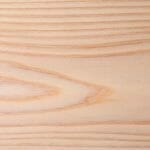
Cedar
Cedar is a softwood with a pale, reddish color resembling spruce. It doesn’t have the same dynamic range as spruce, but it does have a distinctly warm tone that you won’t hear in other tonewoods.
It’s a fantastic choice for musicians who desire a more laid-back guitar that is intimate and responsive to light strumming and fingerpicking.
Cedar is typically used on classical guitars. However, some manufacturers, such as Taylor, use cedar for steel-string guitar construction.
The disadvantage of cedar is that it doesn’t stand up well to heavy strumming and can “blow out” if played hard.
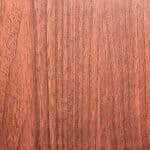
Mahogany
Mahogany is a dark-colored hardwood. When used as a top wood, it has a classic vintage sound that is warm and soothing.
Mahogany is an ideal guitar for blues & folk music and solo performers.
Mahogany tops work well for fingerpicking because the wood is sensitive to a light touch and has a long sustain.
Another advantage of using mahogany as a top wood is that it naturally compresses the tone of the guitar. This can assist players in sounding more consistent in their playing.

Koa
Koa is a hard, lightweight wood found in Hawaii and is used on many high-end acoustic guitars. In my opinion, it’s the world’s most beautiful-looking tonewoods.
Koa has a bright, clear sound with good projection and sustain. It’s great for cutting through a loud mix of other instruments.
Koa-topped guitars are bright, and Koa isn’t for everyone. It may sound too overwhelming and brittle if you play with heavy picks.
However, suppose you’re a musician who prefers to finger strum. In that case, the increased brightness of Koa may help the projection and clarity of the top-end frequencies of your guitar.
Back and Sides
The body wood affects the EQ curves of the guitar. In contrast to the top wood, which predominantly influences playability, dynamic range, and projection.
Guitars that move beyond the $2,000 price range can get into some unique alternative woods and constructions.
Because alternative woods are frequently compared to the most popular woods, I will only cover the often used ones for this article.
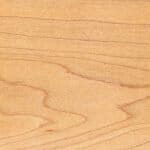
Maple
Maple wood is one of the most beautiful-looking tonewoods. It’s commonly referred to as having a bright, clear tone.
Maple’s lack of overtones makes it ideal for strumming. It helps bring out each note within a chord and sounds articulate and balanced.
Maple is frequently used on Jumbo guitars and other instruments where projection is the primary goal.
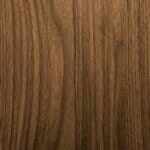
Walnut
Walnut is a more woody and warm version of maple. Walnut has an excellent bass response and long sustain that bold strummers love.
If you want the clarity and projection of maple but with a little more mid-range warmth, a Walnut body and sides guitar is a great option!
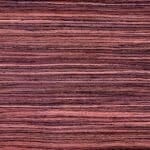
Rosewood
Rosewood has been the most popular back and sides tonewood for constructing high-end acoustic guitars.
Rosewood has a “scooped” midrange that singers love because their voice can occupy the mid-range frequencies range without clashing against the guitar’s sound.
Mahogany
Mahogany is a popular tonewood for guitar bodies. It provides a classic “bluesy” sound and looks fantastic.
It’s durable and helps softer woods like Cedar or Spruce have more projection and sustain.
Koa
Koa has a comparable tone to mahogany, although it has a more brilliant high-end. If you’re looking for an acoustic guitar to have articulate highs that can cut through a dense mix, Koa is an excellent option.
While Koa is a very beautiful tonewood, the emphasized high-end might be too shrill to some. However, the tone will dampen as the tonewood ages.
Scale Length
The scale length doubles the distance between the bridge saddle and the 12th fret.
A full-size guitar has a scale length of around 25.4 inches, while a shorter-scale instrument has a roughly 24.7-inch scale length.
Shorter-scale guitars have less string tension, resulting in a “slinkier” playing experience. This makes the guitar easier to play. Short-scale guitars generally have a warmer midrange tone as well.
However, full-scale guitars generally maintain tuning better when playing in alternate tunings.
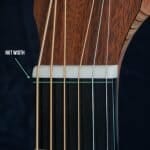
Nut Width
The nut width is the distance between the strings on the guitar and the edge of the fretboard.
Standard nut widths are:
- Small: 1 11/18” (1.61 inches)
- Average: 1 3/4” (1.73 inches)
- Large: 1 7/8” (1.875 inches)
Look for a balance that is comfortable for your hand size. If you have large hands, opt for something in the average to large size for a wider-neck guitar; choose something smaller if you have tiny hands.
Neck Shape/Radius
The neck radius of a guitar impacts how it feels in your hand.
A 7″ to 9″ neck radius is more rounded and pleasant for chord playing, but it wouldn’t be as comfortable for playing scales.
On the other hand, a 16″ neck radius will feel more like an electric guitar and have a quicker response, making it perfect for “shredding.”
Tapering necks are typical on premium guitars, where the neck is thicker at the nut for open chords and thins out as you move up the fingerboard.
Tapering necks often provide unparalleled comfort and playability.

Soundboard Bracing
When shopping for a guitar, the most common bracing systems are:
A guitar’s bracing is a system of internal support that strengthens the guitar. It also has an immediate influence on how your guitar resonates.
- Unscalloped X-Bracing
- Scalloped X-Bracing
- V-Class Bracing
Scalloped X-bracing is the most frequent type of acoustic guitar bracing. The term “scalloped X-bracing” refers to the internal bracing being shaved away for the soundboard to vibrate more easily.
Scalloped X-bracing gives acoustic guitars better dynamic range, projection, and bass response. However, a downside of this bracing system is the loss of note sustain.
Unscalloped X-Bracing, on the other hand, does not remove wood from the internal bracing. This results in excellent stability in the top wood, producing a more balanced, sustained tone. However, you’ll lose some loudness because the top wood doesn’t vibrate as rapidly.
The Taylor V-Class Bracing is a Taylor-exclusive design by head luthier Andy Powers.
Taylor’s V-Class Bracing is designed to enhance a guitar’s loudness and sustain while also providing near-perfect intonation. It’s a significant step forward for guitar manufacturing and one of the reasons I prefer Taylor guitars to other brands.
FAQ
Your most pressing questions about high-end acoustic guitars answered!
Do I need to buy a high-end acoustic guitar to sound professional?
No, you don’t need to buy a high-end acoustic guitar to sound professional. A great player will be able to make any guitar sound good.
However, high-end acoustic guitars will typically have better tone and sound quality than a cheaper guitar model.
If you’re just starting, I recommend buying a more inexpensive acoustic guitar until you figure out what type of music you want to play and what kind of sound you’re looking for.
Once you have a better idea of what you want, you can start shopping for higher-priced models.
What is the most expensive brand of acoustic guitar?
Each guitar manufacturer on this list has some expensive guitars in their lineup, making them all costly brands.
If you go through one of these guitar brands’ custom shops to build you a guitar, you can get guitars made that are the price of a new car.
However, expensive doesn’t always equate to better. There are a lot of incredible guitars that are less than $2,000 that will play and sound really good.
Remember, it is more about the player than the gear.
Are high-end acoustic guitars worth it?
Yes and no. Suppose you are an experienced player that knows what you’re looking for. In that case, a high-end acoustic guitar is definitely worth the investment.
However, it’s not worth the extra money to purchase a high-end guitar if you are a beginner.
A lower-priced acoustic guitar will do just fine until you’ve developed your skills and better understand what you’re looking for in a guitar.
At the end of the day, it all comes down to personal preference. Some people prefer the sound and feel of high-end guitars, while others find them too expensive and overwhelming.
The best thing to do is try out different guitars until you find one that feels right for your playing style and ability level.
What is the best acoustic guitar money can buy?
The best acoustic guitar that money can buy is the one that you can afford.
Most guitar players will never need to purchase high-end acoustic guitars because their skill level doesn’t warrant it. The design and nuances that go into high-end acoustic guitars are catered to the experienced player.
Once you get above $3,000 for an acoustic guitar, you enter the “buy it only if you can afford it and know why you need it” category.
What are the benefits of purchasing a high-end acoustic guitar?
The tone and sound of a high-end acoustic guitar are dramatically better than those of lower-quality guitars.
This is due to many factors, but one significant factor is the solid wood used to produce the top-of-the-line instruments.
High-end acoustic guitars are much more articulate than their less expensive counterparts. They sound deep and resonant in the lower registers. They also have exceptional clarity when it comes to the trebles.
The craftsmanship that goes into constructing a high-end acoustic guitar is unrivaled. From the wood to the complex inlay work, no aspect is overlooked. As a result, they have a stunning sound and look.
Furthermore, high-end acoustic guitars are designed to last a lifetime. The finest materials, technologies, and handcrafted construction ensure that your guitar can become a family heirloom.
Suppose you’re searching for a long-lasting instrument that won’t disappoint you. In that case, high-end acoustic guitar brands are worth considering.
To Recap
The Taylor Guitars 914 is one of the best high-end acoustic guitars in 2024. It has a beautiful and elegant sound and is comfortable to play. It also comes with a great electronics system, is sustainably made, and is versatile.
So many other guitars on the market offer great features, but we believe you’ll love what this one has to offer!
Thanks for reading and happy music-making!
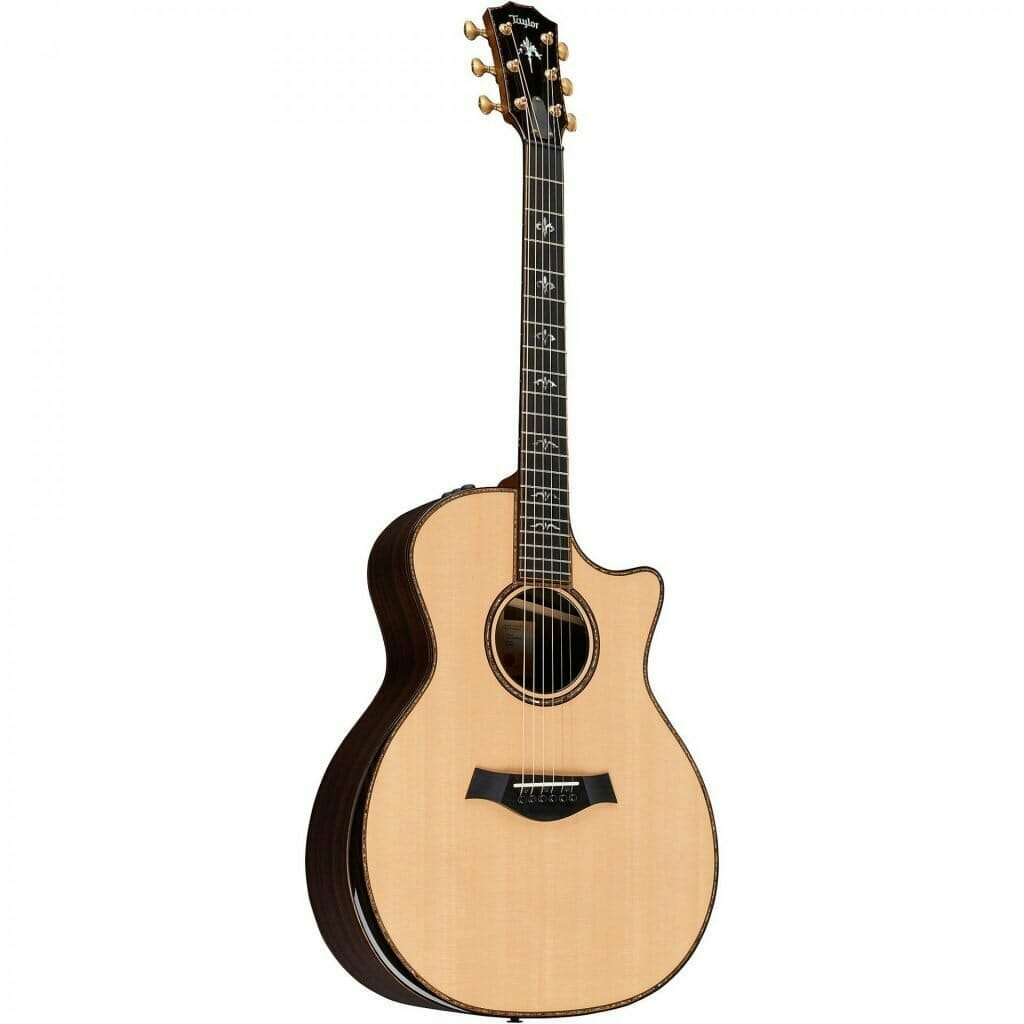
- The guitar's tone is clear, crisp, and high-fi
- Taylor is one of the most creative and cutting-edge guitar builders today
- This guitar is easy to play and sounds excellent amplified
- It's an investment that will last you a lifetime
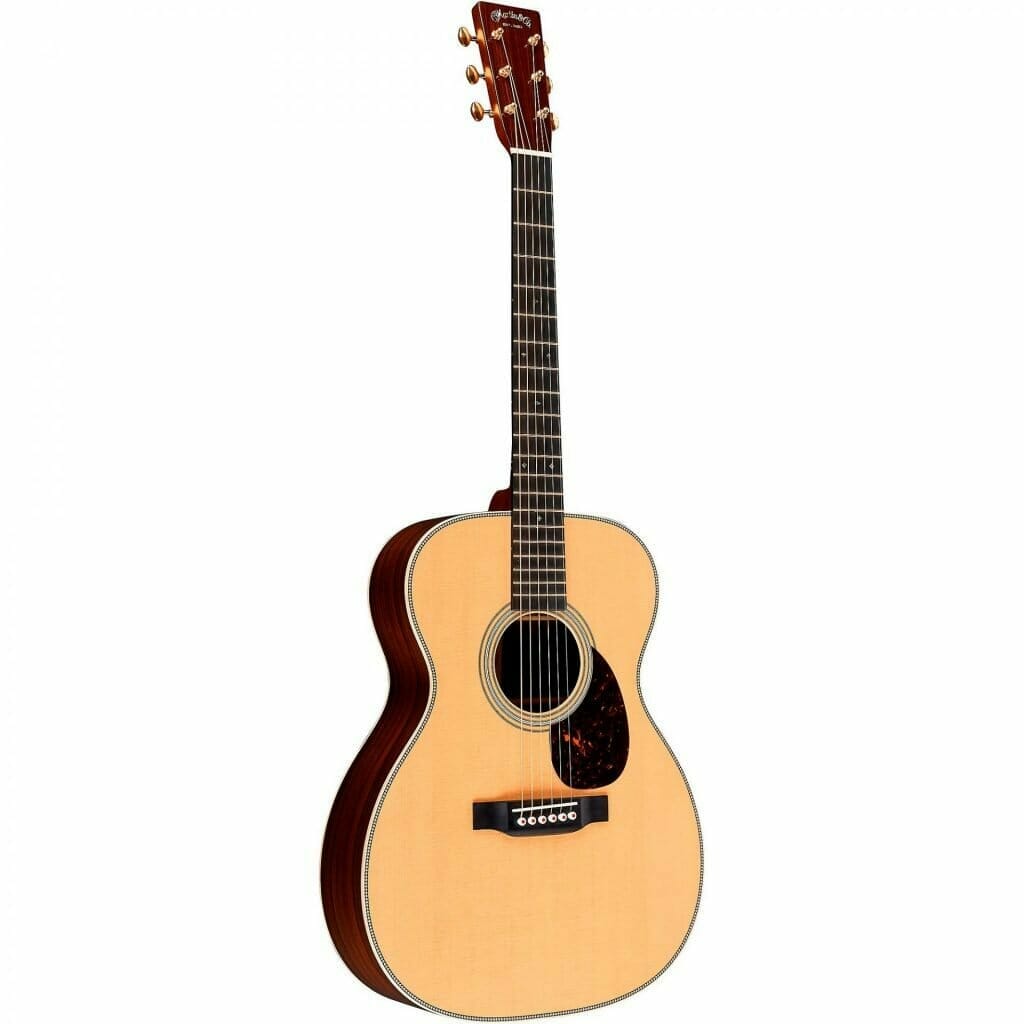
- A guitar with a rich tone that sounds familiar and inviting
- The neck profile is more comfortable and less bulky than a vintage instrument
- OM body style adds articulation, focus, and punch to the sound
- A beautifully built guitar with a vintage look, but modern playability and design features

